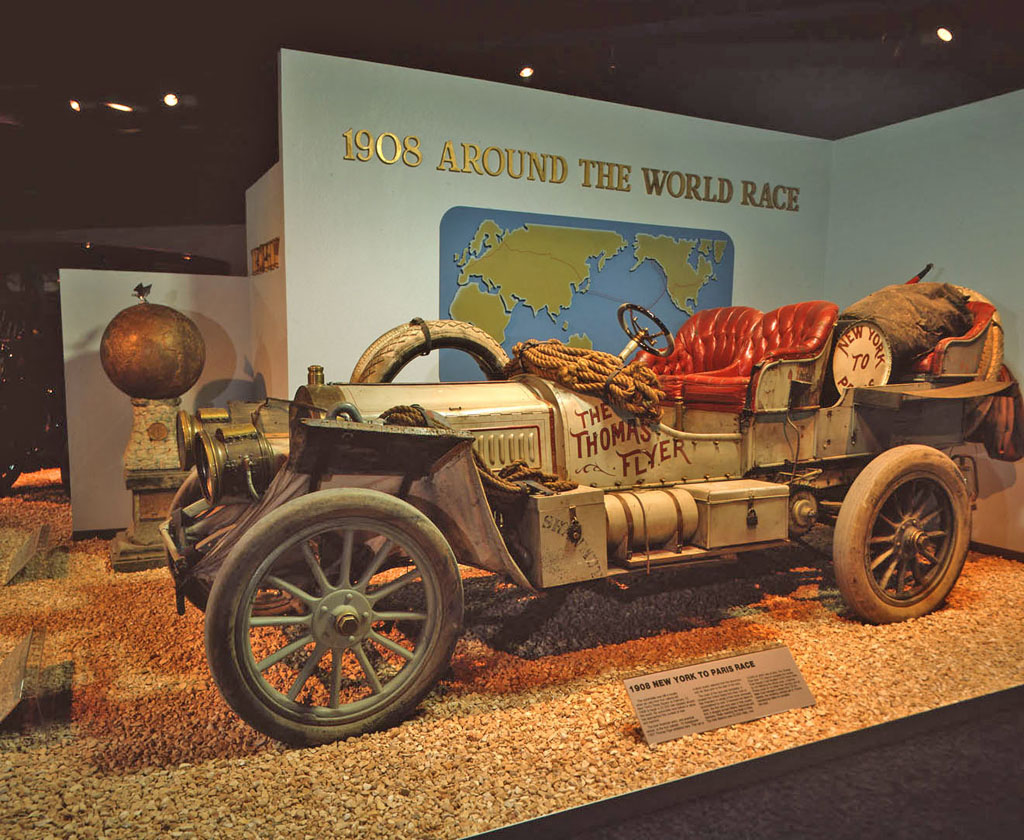1907 Thomas Flyer Model 35
At the beginning of the 20th century, the dawn of the automobile industry motivated several ambitious and expansive races. The most adventurous of these was an around-the-world event called the Great Race. It was run across four continents and in the dead of winter to pass the frozen Bering Straits that linked Alaska to Russia. With few roads, hostile conditions, language barriers and mechanical failures, courage, endurance and ingenuity were paramount.
The first and only instance of the Great Race was won in 1908 by this Thomas Flyer from Buffalo. Automotive manufacturer E.R. Thomas took advantage of a last minute offer to enter the inaugural edition of the Great Race and represent America. Available was one of his expensive and lavish Model 35 chassis which featured a standard 70 hp, four cylinder engine. Quick preparations were made over three days that included a larger fuel tank, running boards which could be used as planks for traction and spare tires.
Sponsored and championed by the New York Times, over 250 000 people came out to witness the start of the 1908 Great Race. The Thomas team faced seven other teams, each from a different country. Their 22 000 mile journey initially embarked across America in the dead of winter. The Thomas team reached San Francisco first and pioneered cross-country travel in winter.
Before the Thomas Flyer even reached the shores of San Francisco, its key team members were swapped, leaving only George Schuster to do the full distance. He was joined by George Schuster, NY Times Correspondent George MacAdam and assistant Hans Hendrik Hansen along the way to the west coast.
Once across America, the Flyer was shipped up to Valdez, Alaska and was the first car ever seen in the state. Upon arrival, the route which included the Yukon River and Bering Strait was deemed too treacherous, so the car was shipped to Japan via the steamer S.S. Shawmut and continued westward through Russia. Often with no roads, the team was forced to go off road on oxen and horse trails stuck through mud and snow. Sometimes the route included traversing rail lines on top of the rail ties. Unrest near the Trans-Siberian Railway meant that each team member kept guns on board and sleep was limited to Russian bunkers.
The rest of the journey was arduous, and left each team to find their own way to Germany. Long nights, rough trails, uncooperative authorities and mechanical failure made the trip even harder. After 169 days of travel, the American team made it to Paris behind the second place German team which was penalized for using train transport and skipping the Alaskan leg of the journey. Upon their return to New York, President Ted Roosevelt invited the team to join him at his White House in Long Island.
In the end the Thomas Flyer team drove 13,341 miles over 88 170 days. During the trip, the engine retained the same spark plugs, craft shaft bearings and valves.
After the ordeal was over, Thomas sales increased, but not enough to save the company. In 1912, production ceased of the then current six cylinder model.
Since no other races were held, the Thomas Flyer remained the only car to win an around-the-world race. The winning car was purchased by William Harrah for inclusion into his impressive car collection. It was restored back to its race-winning configuration including a cracked front headlight. In this condition it was stored at his National Auto Museum in Reno, Nevada. For 2008, the car is scheduled to make many appearances in support of the centennial running of the Great Race. It will be prominently displayed at the upcoming Amelia Island Concours as well.
Story by Supercars.net
In Detail
| submitted by | Richard Owen |
| price $ | $4500 |
| aspiration | Inline-4 |
| displacement | 9357 cc / 571 in³ |
| bore | 146.05 mm / 5.75 in |
| stroke | 139.7 mm / 5.5 in |
| power | 52.2 kw / 70 bhp |
| specific output | 7.48 bhp per litre |
| bhp/weight | 30.86 bhp per tonne |
| curb weight | 2268 kg / 5000 lbs |







